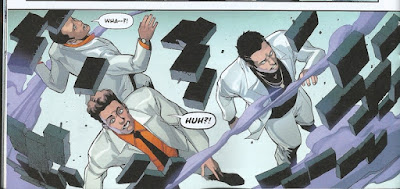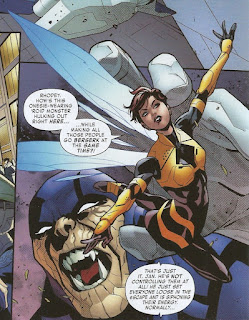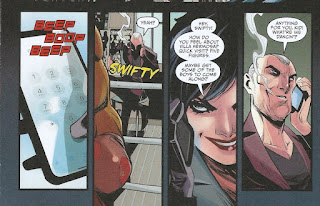Pick of the Brown Bag
March 13, 2019
by
Ray Tate
Welcome once again to the Pick of the Brown Bag. My name is Ray Tate, and I pick the best and the worst comic books of the week. The current reading list consists of Catwoman, Ghost Spider, Iron Man, James Bond Origin, Outer Darkness, Red Hood, Supergirl, Titans, Unbeatable Squirrel Girl and X-23. Just to be suspenseful, I'm not going to identify the turkeys in the preamble. I'm kidding. All the books were pretty good. Several outstanding. You can find fresh tweeted reviews on MySpace. Nah. It's Twitter, of course: #PickoftheBrownBag.
Outer Darkness relates a tale of anti-Star Trek that nevertheless results in some of the same outcomes. For example, Captain Riggs of the starship Charon doesn't give a damn about the crew's lives. He won't let them die because Lucy, there would be a whole lot of explaining to do to his superiors.
Given that his assignment on The Charon is his last chance, the crews' lives are of tantamount importance. Unless Riggs feels the need to sacrifice somebody to the Engine. Magic is thing in the Outer Darkness. Exorcists and mathematicians are equals.
The story begins with sexual hijinks from an unusual source. Cat people are common in space. Outer Darkness promotes a multitude of alien races. The feline is in fact a somebody we met before and will be surprised to see again.
Agwe's and his company's plans are however interrupted.
Last issue, the more altruistic crewmen disobeyed Captain Riggs' orders to leave behind a cryogenically preserved Lieutenant that happened to be possessed by an arch-demon. That as you can see didn't work out.
He calms down and forms an away team to search for shelter while the ship receives repairs. Thus mirroring Federation protocol.
That's until the reader lets out a gasp as Sato Shin asks to be included, blatantly lying in the process. For those not in the know, the gasp of shock is rewarded in the final pages.
Dan Abnett turns the tables on the antagonists he elegantly introduced. For this issue of Titans every plot thread meets. The heroes begin to win, but it feels less like a complete victory than a culmination of chaotic happenstances. The Titans simply take advantage of an opening. Thus, the story gains depth and realism.
In Justice League, The Source Wall, a Kirby creation associated with the New Gods, shattered. Eldritch energy bathed the universe. Meta-humans popped up everywhere.
Dick Grayson encountered and lost one. Before he suffered life-changing trauma, he asked Batman, Superman and Wonder Woman for an opportunity. He intended to form a new team of Titans to address the situation.
Tom Hinton is one of the metas. A fantasy writer, he created the Unearth. Imbued by the Source Wall, Hinton's Unearth became real, and in this realm, Prince Travesty reigns.
Unbeknownst to the creator, the creation colluded with Mother Blood. In a bid to suffuse the multiverse with the Red, Mother Blood made all sorts of brilliant moves against the Titans.
Mother Blood's plans for multiverse domination fizzle in unpredictable ways along with her control of Garfield Logan, the Beast Boy. Though not before Titans leader Donna Troy gets in a few good licks in.
Red Hood is such a joy to read. Scott Lobdell's unrelenting love for Jason Todd just blazes through the latest issue of Red Hood.
His relationship with the Penguin became personal when he discovered the Penguin had been instrumental in the killing his father. So, he shot him in the face on national television.
Beyond angry, Batman fought Jason and vowed to bring him in. Arsenal the archer formerly known as Speedy interrupted their duel.
Because of events in Heroes in Crisis, Batman tracked Jason down in his hunt to dismantle the Underlife. Only, not to fight. Just to talk. The Penguin survived. Mainly because Batman writer Tom King needed him. Nevertheless, Red Hood became wanted by law enforcement all over the planet, especially Gotham.
Last Red Hood, Jason ended the Underlife and did the one thing nobody expected. He returned to Gotham with an audacious plan.
Jason bought the Iceberg, the "missing" Penguin's nightclub. He also did something really smart. He bought out his enemies.
That purchase includes Suzi's sisters. At the same time, Jason's strategic move is solid economics. The Iceberg depended on a female presence. Jason's replacement of the Penguin's henchwenches with the same dynamic ensures a faithful feed of revenue.
Jason had help when ending the Underlife, and he put these gents including estranged Teen Titan Blockade on the payroll.
Jason's purchase of the Iceberg opens a new chapter for Red Hood and the Outlaws. It does this by recapitulating Jason's m.o. He baits Batman with a comic reversal of televised calm.
Batman finds himself outmaneuvered by his own setup, and then writer Lobdell reveals the juiciest secret of Jason's new role at the cliffhanger.
Gold funded wars throughout history, and World War II is no different. A Russian freighter escorts gold bullion to a Norwegian ship. Ostensibly to oil the gears in the war machine against the Nazis. Just one problem.
The Russians intend to keep the gold. Their goals lead to bloodshed and mayhem at sea. James Bond serving undercover on the H.M.S. Boudica soon uses the lessons he learned to uncover the truth.
The Captain of Boudica finds Bond's suspicions a nuisance. So Bond begins exhibiting the characteristics he'll use to survive in the future. He disobeys orders and conducts a personal investigation.
The foray establishes Bond's penchant for upsetting rogue Russian schemes and grants the traitorous mastermind the first opportunity to lord over Bond with the promise of death. It's not exactly a laser threatening to split him into two, but the sentiment is identical. Bond, James Bond.
Jason had help when ending the Underlife, and he put these gents including estranged Teen Titan Blockade on the payroll.
Jason's purchase of the Iceberg opens a new chapter for Red Hood and the Outlaws. It does this by recapitulating Jason's m.o. He baits Batman with a comic reversal of televised calm.
Batman finds himself outmaneuvered by his own setup, and then writer Lobdell reveals the juiciest secret of Jason's new role at the cliffhanger.
Gold funded wars throughout history, and World War II is no different. A Russian freighter escorts gold bullion to a Norwegian ship. Ostensibly to oil the gears in the war machine against the Nazis. Just one problem.
The Russians intend to keep the gold. Their goals lead to bloodshed and mayhem at sea. James Bond serving undercover on the H.M.S. Boudica soon uses the lessons he learned to uncover the truth.
The Captain of Boudica finds Bond's suspicions a nuisance. So Bond begins exhibiting the characteristics he'll use to survive in the future. He disobeys orders and conducts a personal investigation.
The foray establishes Bond's penchant for upsetting rogue Russian schemes and grants the traitorous mastermind the first opportunity to lord over Bond with the promise of death. It's not exactly a laser threatening to split him into two, but the sentiment is identical. Bond, James Bond.
Tony Sark alias Iron Man only wanted to give the world a virtual reality platform that served as an immersive experience like no other. It was meant strictly for entertainment, but the low rent villain the Controller got wind of it. He mind-controlled one of Stark's most loyal employees and saw Stark's game as a means to the end of leeching off of every mind on the planet. Jim Rhodes and the Wasp have got this.
What they haven't got. What nobody could have predicted was Maria Stark's virtual resurrection. Howard Stark really loved his wife,Tony's mother. H. Stark in fact used her mind print as the a.i. handler of his Nazi fighting android Arsenal, revealed in a classic Avengers Annual.
Tony used Arsenal as a Terms of Service enforcer. Made sense. Tony wanted a memorial for his parents. Though he didn't put Maria Stark in the program at least not consciously.The problem arises when mother meets mother. Rocker Amanda Armstrong is apparently Tony Stark's biological mother. I wasn't actually aware of this until a buddy explained it to me.
Of course, this is somewhat preposterous given Iron Man's history. Retroactively speaking, Amanda would have been a jazz singer in Iron Man's original adventures. Why Marvel didn't make her a classical pianist and timeless I'll never know.
Anyways. I like Amanda. So, whatever. Maria Stark plays dirty with allusions to the Iron Man cartoon from the sixties and another Avenger with a rather bosomy non-pc look.
Slott also redeems the Machine Man from Warren Ellis' Nextwave incarnation. Mind you, he's still prickly.
All of the chaos nevertheless beautifully illustrated by Valerio Schiti and Paolo Rivera leads to a startling conclusion that has nothing to do with the foreshadowing of alcoholism promoted on the weird covers.
In an alternate future or perhaps the true timeline, the older Squirrel Girl encounters Kang the Conqueror, who has never looked more hilarious thanks to artist Naomi Franquiz.
Kang as depicted resembles a cross of artistic styles. The classic Kirby version who clearly wore a bizarre costume with wrinkles and all as well as a hunter's mask and the cartooning of the late, great Charles Schultz.
When Kang fails to set off a trap he believed that he would have prepared years ago, he travels into the past where he meets present day Squirrel Girl through the artistic talent of Derek Charm.
Original Unbeatable Squirrel Girl artist Erica Henderson returns because Kang simply can't win. So, he faces an adolescent Squirrel Girl and her pal Squirrel Monkey Joe.
X-23 meets up with her All-New Wolverine foe, and finds him a little philosophical about the damage she did to him.
Like the best loser villain, the mad Big Bad believes he's going to win. He believes he has the upper hand. After all, he's backed by a controllable army of Laura clones.
He also doesn't believe that he's completely insane and he doesn't recognize ethics. His goal is simple to further his genius with the goal of making oodles of money. Laura is just in his way.
There's nothing at all personal in his intent to terminate her. He's also not so full of himself that he believes he will succeed where others failed. He simply does not care.
In addition to choreographing a monstrous battle artist Diego Olortegui demonstrates the efficacy of Laura's healing abilities. Laura by the end of the scene is left in a seldom seen completely ravaged state, but by the time of the next page her healing power kicks in and we see her kicking butt with Gabby and her reformed charge.
The art is such a boon in X-23, along with the inks of Walden Wong and colorist Chris O'Halloran, that you may ask what writer Mariko Tamaki's part in all of this is.
Tamki demonstrates the good in Laura conquers evil. Laura's inherently positive traits sabotaged Gabby's grooming as an assassin. Laura's own experience and love allowed her to adopt Gabby and give her the benefit of reinforcement. The Gabby that fights alongside of Laura now is the result of Laura's constant kindness and warmth. Gabby conveyed the consequences of Laura's benevolent presence to her friend and new sister. That changes the tide of battle, and that's why X-23 is still a superhero comic book you should own.
Supergirl is hunting the killer of Krypton Rogol Zaar. Wait. Says you. You thought Krypton exploded through debatable natural causes. It's a Bendis thing.
It appears Rogol Zaar was the instrument of a clandestine group called The Circle. The Circle, which included a Guardian of the Universe, condemned Krypton.
Kara took to space to find answers. Her questions led her to a team-up with the Omega Men, a confrontation with the vicious, dim-witted Khunds and an encounter with intergalactic conman Harry Hokum. Hokum's involvement resulted in this.
Kara took to space to find answers. Her questions led her to a team-up with the Omega Men, a confrontation with the vicious, dim-witted Khunds and an encounter with intergalactic conman Harry Hokum. Hokum's involvement resulted in this.
Like Laura Kinney, Kara fights a clone army of herself. These clones however are much more pitiable creatures, and while Kara fights, she doesn't lose herself to bloodlust. Writer Marc Andreyko makes her a symbol of hope.
In order to be susceptible to courage, kindness and love. You must want it. Alas things do not go according to Kara's wishes, and Kara knows who to blame.
Kara loses Hokum through unexpected means, but she gains a clue.
What the story winds up being is one part science fiction horror and one part detective story threaded through a budding friendship with the Omega Men.
The inventory issue of Catwoman by Ram V. gives me everything that I want from a Catwoman book. Catwoman committing a heist. That’s really all I want from a Catwoman series. Selina Kyle perpetrating heists. I like her relationship with Batman. I like her being considered a defacto hero, but foremost in my philosophy. Batman is "The World's Greatest Detective." Catwoman is "The World's Greatest Thief."
Ram's story takes place in Selina's newest window sill Villa Hermosa. An injustice against her friend in the Villa triggers Selina’s actions, yet the story could have taken place anywhere with any friend. You don't need to understand current continuity or her current situation to grok this stand-alone.
For example, Detective Headly could have been Bullock or even Montoya. He could have been Ellery Queen or Sherlock. It doesn't matter. He exists to fill a role.
That’s admittedly kind of formulaic, but formulaic writing isn’t bad in itself. It can be boring. It can be thin. It doesn’t have to be. Catwoman is certainly a fine example of formula.
Every heist production should have something special about it. In Catwoman, Ram and artist John Timms play with the visuals, chip the fourth wall and create onomatopoeia. All to flavor the story.
The creative team including justifiably singled out letterer Josh Reed do not just introduce characters in dialogue and such. They slap their names across the panels. As if Catwoman were a hip movie.
The creative team including justifiably singled out letterer Josh Reed do not just introduce characters in dialogue and such. They slap their names across the panels. As if Catwoman were a hip movie.
The Cha-Cha-Cha gives Catwoman a score to accompany the big score. It's presence exemplifies the uniqueness of the comic book format.
As to the heist, Selina's target is the Broker. Her gang are old friends. She appears as both Selina and Catwoman. Despite her not being able to predict every step in the dance, she commits her crime flawlessly. Cha-Cha-Cha.
As to the heist, Selina's target is the Broker. Her gang are old friends. She appears as both Selina and Catwoman. Despite her not being able to predict every step in the dance, she commits her crime flawlessly. Cha-Cha-Cha.
In the last issue of Ghost Spider three themes evolved. One, Gwen meets up with a woman who lost a purse with important keys inside. She pays Gwen when she retrieves it. This gives Gwen an idea.
Ordinary spiders appear to be imprinting on Gwen. This could be something sinister, and/or it could be excellent Spider-Gwen writer Seanan McGuire calling back to one of Spider-Man's lesser utilized powers. Limited control of arachnids. True.
Spider-Gwen also inadvertently riled up the new allusive Big Bad when she foiled a hostage situation.
No. The Bodega Bandit is not the Big Bad. He does though as you can see take a bow, in an aside that demonstrates just how dangerous he is to anybody. Not at all.
The actual Big Bad is trying to get a measure of Gwen's talent, which leads to some crazy Takeshi Miyazawa fight choreography.
Because Gwen did time, everybody knows her identity. Including her bandmates in the Mary Janes.
The story is a simple Day in the Life of Gwen Stacy, alias Ghost Spider nee Spider-Woman. Also known as Spider-Gwen. McGuire teases out a arc the old fashioned way while Miyazawa lighthearted artwork welcomes you. Easily gets the award for most improved title. As much as I liked Jason Latour's writing, his Spider-Gwen just became to complicated and relied on plot devices that left me cold. This return to basics is much needed.























































No comments:
Post a Comment